Natural history, art museum leaders at UMass raise concerns about storage of collections
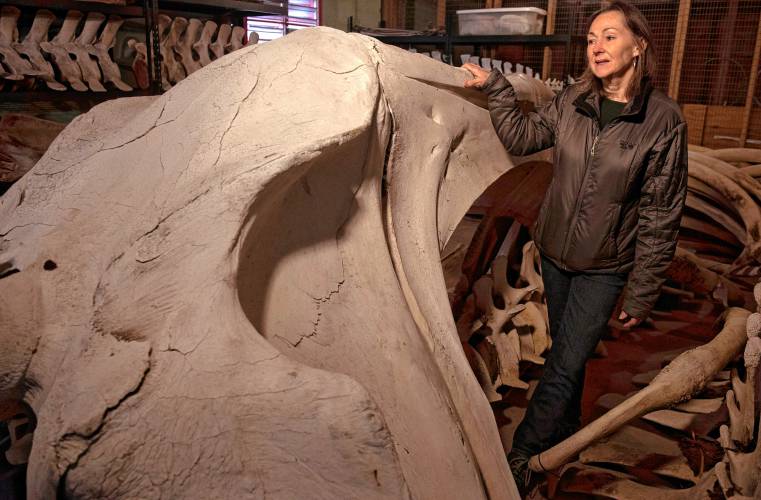
UMass Collections Manager Katherine Doyle stands with a right whale called Staccato, which has been part of the UMass natural history collection for about 30 years. Doyle says that because UMass doesn’t have a natural history museum, “so many useful and interesting specimens are behind doors.” STAFF PHOTO/CAROL LOLLIS
|
Published: 03-04-2024 11:01 AM
Modified: 03-04-2024 7:04 PM |
UMass does not have a natural history museum, something of a quirk of history.
Specimens from the university’s collection were once stored and displayed in large glass cases in South College, which burned down in the late 1800s. The collection was shuttled to Fernald Hall, then moved to Morrill Science Center, where no display space was available.
“For a land-grant university not to have a natural history museum is unusual,” said Natural History Collections Manager Kate Doyle. “We have so many useful and interesting specimens that are behind doors.”
Those specimens include three taxidermied passenger pigeons from this region, now extinct. The collection’s thousands of blown bird eggs were used to help prove that the pesticide DDT causes eggshell thinning, a threat to bird life that prompted biologist Rachel Carson to write the classic book “Silent Spring,” which inspired the modern environmental movement.
While having its own space, the UMass Museum of Contemporary Art likewise faces struggles.
“We’ve just outgrown our original storage space, to the point that it’s a concern, because all the works are held in the public trust,” said interim Director Amanda Herman.
Moreover, because the art museum is located behind and downstairs from the Fine Arts Center performance space in the same building, it can go unnoticed, Herman said.
“A lot of people have never been to the museum, which makes me sad,” she said.
Article continues after...
Yesterday's Most Read Articles
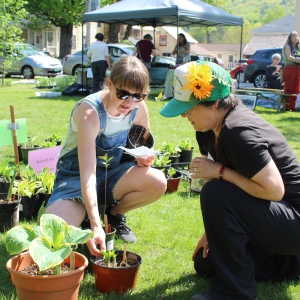 Bridge of Flowers in Shelburne Falls to open on plant sale day, May 11
Bridge of Flowers in Shelburne Falls to open on plant sale day, May 11
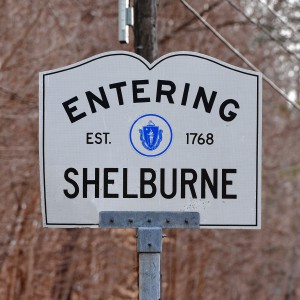 Serious barn fire averted due to quick response in Shelburne
Serious barn fire averted due to quick response in Shelburne
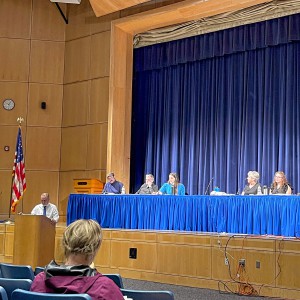 $12.14M school budget draws discussion at Montague Town Meeting
$12.14M school budget draws discussion at Montague Town Meeting
 As I See It: Between Israel and Palestine: Which side should we be on, and why?
As I See It: Between Israel and Palestine: Which side should we be on, and why?
 Greenfield homicide victim to be memorialized in Pittsfield
Greenfield homicide victim to be memorialized in Pittsfield
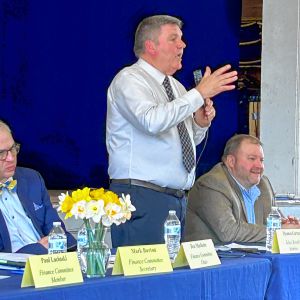 ‘We are among the leaders’: Ashfield Town Meeting voters pass bevy of clean energy proposals
‘We are among the leaders’: Ashfield Town Meeting voters pass bevy of clean energy proposals
UMass has a new chancellor this year, Javier A. Reyes. With a new strategic plan also in progress for the university, Doyle and Herman hope it may be time to reconsider how UMass’ collections are housed.
“Wouldn’t it be the most revolutionary idea, to have a combined contemporary art and natural history museum?” Doyle asked.
UMass has, Herman noted, recently upgraded the existing fine art storage space to safeguard the art.
In an email, UMass spokesperson Edward Blaguszewski said the university “has committed to funding development of a new storage space for the fine art collection.” The goal, he said, would include “identifying a suitable facility, securing additional funding for the project, and creating a space in which it can both ensure the safekeeping and expand the accessibility of UMCA’s collection.”
However, “I’m not aware of any current plans to create a natural history museum,” he said.
For Indigenous artist Courtney M. Leonard, whose installation inspired by the UMass-owned skeleton of the right whale Staccato is showing at UMCA, such conversations are part of what she hopes to spark with her art.
“Our community doesn’t easily have access to the remains of a whale, which is part of our cultural ties and ways of being,” Leonard said. “[Staccato] being a very large specimen — a northern right whale is quite large — it’s located on campus, but it’s not in a very accessible place unless it’s pulled out for education.”
Such questions sit alongside the larger and more thorny questions of care, protection and restitution for Indigenous peoples, right whales and the landscapes they rely on.
“I wanted to see this [exhibition] space be about how we gather, how we heal and how we think through intentionality,” Leonard said. “My question is … how far do you want to go in your care for Staccato? And that symbol of Staccato is just like the current issue of the protection, not just of northern right whales, but of the entire ecosystem.”

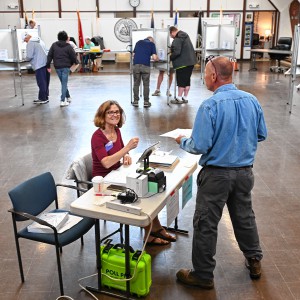 Political newcomer defeats Shores Ness for Deerfield Selectboard seat
Political newcomer defeats Shores Ness for Deerfield Selectboard seat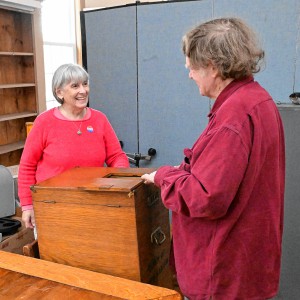 New Salem election ushers in new Selectboard member
New Salem election ushers in new Selectboard member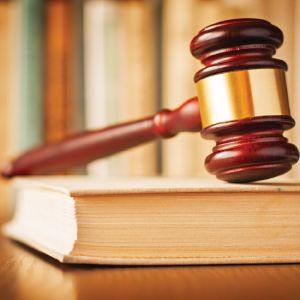 Community Legal Aid expands Disability Benefits Project to Franklin County
Community Legal Aid expands Disability Benefits Project to Franklin County
